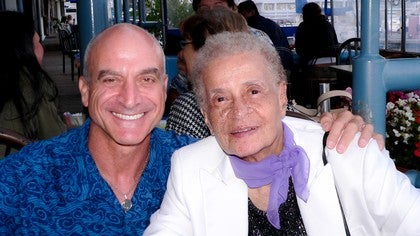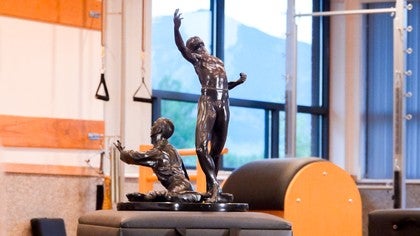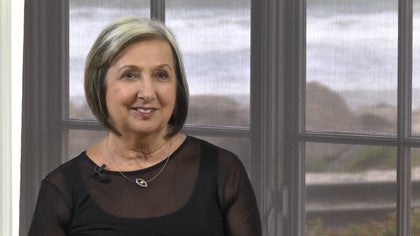Description
About This Video
Transcript
Read Full Transcript
When did you name it? Bassi Body Arts and Science International. Cause I know when I took it in the beginning. Yeah. Not from the beginning. Um, I believe it was around 92 93, you know, the, the, the concept was there, the training organization was there, I believe in the early nineties, became a body arts and science. And then we changed it to body arts and science international and then Bassey prologis. And I think Betsy ballade is here to stay. So was the naming related to the trademark lawsuit if you're when need speak mid nineties, early nineties, that makes me wonder if that's why. Yeah, so that's a great question. It actually wasn't, you know, I, I called my a studio on center conditioning and that was 1990 1991 or two Christian with that, we trademarked on center conditioning, Body Arts and science on center conditioning. Uh, was one of the first studios in Orange County, one of the first south of Los Angeles that was bigger than the training organization, the studio.
And that was called on-center conditioning and body arts. And Science was this little training program that started growing and growing and flourishing and neither had the name PyLadies in them. And that's quite interesting. I don't know whether it was foresight, uh, for churches. I don't know. But I actually purposefully did not, um, include the name pilotees later on it became quite important because in the mid nineties, there was a huge lawsuit. Uh, and uh, I was quite involved in that and as deposed for that lawsuit, but I never had to fight it for myself in terms of the name of my studio, although I was involved in the class action lawsuit. Um, but no, neither had the word politeness in them and I just somehow felt it was important to create a different identity. Although it was very clear that what I taught was prologis. Christie, you've been such a big part of our growth and you know, you were the first teacher outside of me that taught the program, you and Sally, uh, in Australia. And I mean, you know, what a huge step that was. And um, you know, it was just a tremendous sense of sharing.
I felt so confident with you that I could impart the knowledge and then say, go out and teach it to other people. And that was a huge milestone, a juncture within Betsey's growth and evolution within the legacy because that's when it stopped being focused on me. But became a company, a brand, a really part of a legacy. It started going to the next generation and the next generation and the next generation. And that is part of the long succession plan that you and I have spoken about many times. Right?
And, um, I was introduced to [inaudible] and I was very intrigued by it, uh, because I felt that it was a wonderful meeting ground between what in my mind I categorize this eastern and Western forms of approach to movement. Uh, having done yoga for many years, uh, delved in some of the martial arts. I love that, uh, in, uh, part of the work, the mind part of the work. Uh, but I love the of working out and, um, and having been very involved in exercise physiology and measurements of the body and, and, uh, heart rates and, and I, that all seemed triggered me and I found in [inaudible] as a meeting ground, it was very deep. You could take it as deep as you wanted for a dance. It offered great facility on working on technique.
I saw the same as an athlete and um, it offered a great workout. So I started studying, reading more into it and when I went to, um, London to do to England and then later to London to live in London, I did my graduate studies at the University of Surrey in Guildford. And then I went to live in London. And there I met Alan Herdman. And Alan has been a true inspiration to me through my career. He, you know, we, I think in many ways were, uh, very similar in other ways. We're very different. Uh, I think we both love seeing the minutiae in movements and, and going deep into the movement. And, um, Allen is a wonderful, wonderful friend and teacher and will actually be, I will be hosting a Ellen very soon at one of our big celebrations down here in Newport beach. Um, but the style in England was very, very different to what I later became, uh, acquainted with.
And what I saw was the classical form of politeness. And then I became acquainted with when I came to the United States. Also through some archival materials that I found. And um, I then, uh, came to the states, met Ron Fletcher, who I loved studying with. Um, I went to New York. About what years are we talking now? Um, now we were already talking late eighties, uh, went to New York to take sessions with Ramana who I found was a great inspiration to me and loved Ron and Romana could not have been more different and yet they were both equally as wonderful. Well, sorry, it was run out already in California is already in California. Yeah. And uh, he actually called me one night. I went to his studios visiting, uh, Los Angeles and I went to Ron Fletcher's studio.
He wasn't there that day and I took a session with his teachers, Michael and Diane. And he called me that evening and he said, I heard you did a session at my studio and we had a wonderful talk and he wanted to know about me. And, um, it was fantastic. I then was invited to the states from Australia as a guest artist to choreograph and perform. And that's when I decided to move out yet the invitation of an orthopedic surgeon who wanted me to set up a rehab program for him. He worked a lot with dancers and he was working with cal State Long Beach, California State University, Long Beach. And I was very happy in Australia, but I saw it as an opportunity I could not miss.
It was when I came out here in 1991 that I went out to Santa Fe and met first eve gentry who was another first generation teacher that again could not have been more different, uh, from Ron and from Ramona. She had such a soft, sweet demeanor about her and she was, you know, she's the person we speak of imprinting all the time. She is the person that creates a whole imagery around imprinting. And then, um, a year or two later I met Kathy grant and when Kathy and I met, it was just, you know, we, you meet teachers in your life. I had them in dance, many or wonderful teachers, but there are those that you just check, connect with and they are going to impact your life. And, uh, Cathy impacted my life. And, uh, in many ways, the first meeting, I can't say it was enjoyable. In fact, it was quite traumatic for me as well. There was a group of very seasoned teachers around and she was giving a workshop and she, I can't, can't remember if she asked me to come up and demonstrate or if I foolishly volunteered to demonstrate.
But at that point I'd been doing politesse for 14 years. I was performing as a seasoned performer. I did all the advanced stuff, which Romana would teach me. She didn't do it, but got me to do it. And stuff that I saw in pictures of Joseph [inaudible] is doing, you know, the Highbridge on your head. And it just, you know, things that I had seen in pictures and she was so wonderful in taking me through that repertoire. So I thought, well, you know, I'm certainly eligible to, uh, demonstrate some work and this little lady, and I'm no giant. But she came and started poking and prodding and pushing and shouting at me. And I remember leaving that workshop that evening thinking, Oh God, I have got nothing. Right.
I'm doing nothing. Right. I just felt either I've got to go back to the beginnings and learn how to call again and learn how to do a pelvic curl again, or I need to go back to do something else. Maybe just dawns or, but not do polities. I really was at that point where I felt I had got it wrong way. I had been teaching many people, but after 14 years I felt that I got it wrong. I was performing, but I wasn't doing it right and she, the next day I came in and I said, I'm going to do it right.
I am going to start from the beginning. I'm going to find a deeper meaning in this. I need to see deeper. I need to see what Cathy sees because I wasn't seeing what Kathy sees. Kathy would see your muscles moving before you even knew they were going to move. That's what intrigued me. And that sent my entire organization on a tangent that said Bessie on the tangent that created the Betsy that we know today. In fact, I asked Kathy soon after that to become a, an honorary faculty of Betsy and an honoree advisor.
And she did in the beginning on my brochures. I had Kathy Grant, Henri, uh, adviser Henri Faculty, I can't remember, but that insight, that depth, that exploration, that looking deeper than just the exterior. She was right. I was performing, I was not doing the work. And um, just this week I had a student during a session of mine, uh, kind of crumble and say, I just not feel I'm not doing it right. And then, you know, she shed many tears and I gave her a hug. I said, you know what? This is going to be possibly the most important session you'll ever do. Not because you learn new repertoire.
Cause you're going to go away today and you going to search deep within yourself and find, is this really what I want to be doing? Is this, do I really want to be with rail? And with Betsy and maybe yes, maybe no, but it's going to make you explore. And, uh, Kathy and I then met many times and in 19, um, believe it was 94, we were at a, uh, I Adam's conference, International Association of Dance Medicine and science. I presented for them several times and Kathy was hungry. Students always, always hungry to learn. And it was in San Francisco. I said, Kathy, I want you to come and teach at my studio. And she said, I promise you that if I give another workshop, it's gonna be for you. And about four years later, she called me and she said, the PMA, the [inaudible] method lines have invited me to teach and I won't do it without your permission because I'll be breaking my promise to you. And, uh, I said, of course, teach the whole world needs to see you, not just me.
And she taught. But 14 years later, she fulfilled her promise. And she came and you were there. And it was such a highlight to teach together with Kathy and, uh, to be corrected by Kathy in front of all my students. And,
There's rail. You have to tell him you're not going to the workshop. They told it's just too close. It's too to cook. Listen, I promise you I'll make a chicken. I'm going to make a trip and come on the record. And I mean that, look this, they know there's young kids designed to make a special trip to Wales. Next workshop. I'll see you right here. We're waiting for the elevator. Keep going, keep going.
You know how little children do that and then they go like this, oh, this is a huge person with a great impact on this entire community. Cause I'll say it now, including in my workshop later. This is the essence.
I just want to make sure that wasn't the right,
You're seeing that I was working from my, just the exterior from my muscles. There wasn't an inner exploration and she wanted me to go deeper. She saw the potential for me to go deeper. She saw my love for the one that chair. And in fact she, her and I had many conversations about bringing the one the chair out and we would do it together.
The strange thing is that the one that chair was hardly used at that time, it was almost obsolete. And the one, the chair today is such a fantastically popular piece of equipment.
How you could correct them. Natural excites you. If you look at a pelvic Kurland say, ah, not another pelvic [inaudible]. It's not exciting. You if you, you need to find a meaning and excitement in it to keep going for years and years. And she found that. And, and, and I feel that. I really do. And, and we shared such a very, very close, um, friendship, a real, I think, spiritual connection in a way. We come from such different backnet backgrounds, you know, we could not have come from people don't diverse back.
Kathy was very instrumental and, but she definitely also suffered within herself because of, because of that, you know, here I come along and, and by the way, she also had a son, actually a son, another biological son, but an adopted son who, um, became Muslim. And here I am a very close friend of hers. Uh, a white born in South Africa, Jewish guy who lived in Israel. Um, it was a lot different, different. And yet we found such a strong bond and, uh, not always easy, uh, but very deep and very meaningful. And I hope I can speak for her and saying that it had a lot of love and caring within it. But I know for myself, there was a lot of love and caring and it was, I mean, you know, I, I didn't spend as much time with hers. I'd like to have, there were others that spend much more time with her, like Karisa and like blossom. Um, uh, the, there were many others, but I met her as a mature teacher, mature adult, mature man, and I think our relationship was, was just different. You know, no better, no worse, just different to those others. I've never really shared that much. Only shared it with Karisa recently. Actually, we were in Argentina together, but it was an interesting relationship to navigate.
Pilates Legacy Project: Discussions
Comments
You need to be a subscriber to post a comment.
Please Log In or Create an Account to start your free trial.















